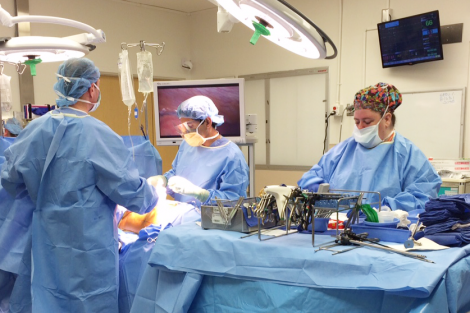UCSF Medical Center, CPMC Join Forces for 18-Patient Kidney Transplant Chain
Chain Believed to be One of Nation’s First in Single City Over 36-Hour Period
A unique collaboration between UCSF Medical Center and Sutter Health’s California Pacific Medical Center (CPMC) resulted in what is believed to be one of the nation’s first nine-way kidney transplant chains occurring in one city over a 36-hour period.
The chain started on Thursday morning (June 4), with an altruistic patient donating a kidney as a token of gratitude for his good health. It concluded with a recipient who has been on dialysis for several years.
The surgeries involved the above donor and recipient and an additional 16 patients – eight recipients, each paired by a friend or family member. These pairs were either blood type or immunologically incompatible with each other but were compatible with other pairs in the group.

UCSF operating room for kidney transplant donor Reid Moran Haywood. Photo by Scott Maier
UCSF Medical Center performed eight of the 18 surgeries, and CPMC did 10. In six cases, the donated kidney travelled across town from one hospital to the other. The majority of the 18 patients came from the Bay Area and Northern California, and a few from as far afield as Hawaii and Massachusetts.
“This collaboration with CPMC enables us to broaden our pool of kidney transplant donors and recipients and treat them at two medical centers separated by only a few miles,” said John Roberts, MD, professor of surgery and chief of UCSF Medical Center Transplant Service. “The proximity of the hospitals means the donated kidney can be swiftly transplanted, minimizing risks to patients. This paired kidney exchange also benefits those on the transplant waiting list and moves up others who are still waiting.”
Robert Osorio, MD, CPMC chair of transplant, said, “This is a natural step for us, building on our six-way paired kidney exchange of earlier this year, the largest conducted on the West Coast. It is gratifying to provide this lifesaving treatment to those in need and to continue to serve wider groups of donor-recipient pairs. The risk of complications for living donors of kidneys is less than 1 percent, and we encourage more people to consider this as an option. We hope this partnership with UCSF will be the first of many to follow.”
Top Destination for Kidney Transplants
Currently one of the largest transplant centers for living kidney transplants nationally, UCSF also has performed more kidney transplants overall than any other center in the country with more than 10,000 since 1964. With a three-year living donor kidney recipient survival rate of 97.29 percent – above the 95.78 percent national average – UCSF has more patients on the kidney transplant waiting list than any other U.S. transplant center.
CPMC is the largest non-academic medical center transplant program in the country and a pioneer in kidney paired donation. As the largest kidney paired donation program on the West Coast, CPMC performs over 200 kidney transplants annually and continues to be identified by the Scientific Registry of Transplant Recipients as having greater than expected three-year adult patient survival rates compared to other kidney transplant centers in the United States.
Over the years, it has become more common for kidney dialysis patients to receive donations from living donors, leading to better outcomes. In 2014, 5,535 kidney transplants came from living donors, according to the National Kidney Foundation. Some 11,570 came from deceased donors, who typically donate both kidneys.

Altruistic donor Reid Moran Haywood, left, and husband Greg Haywood. Photo by Scott Maier
These pairs were not genetically compatible with each other but were genetically matched to one of the other recipients using software developed over the past 10 years by former CPMC kidney transplant patient David Jacobs.
As of April 2015, 101,617 patients are currently waiting for kidney transplants, according to the U.S. Department of Health and Human Services. In California, the waitlist is currently at 18,646. The number of people waiting for a kidney at UCSF is 5,258 and 1,925 at CPMC. The combined total of 7,183 is 7 percent of the U.S. waitlist and 38 percent of the California waitlist.
“This ambitious and lifesaving partnership between UCSF Medical Center and California Pacific Medical Center is a testament to the cooperation that happens in San Francisco’s health sector,” said Barbara Garcia, director of the San Francisco Department of Public Health. “The burden of kidney disease afflicts one in nine people in our country – that’s nearly 100,000 people in San Francisco alone, where the average wait time for a kidney is eight years. Creative approaches like this multi-kidney swap are one tool in the toolbox to transplant more patients.”
About UC San Francisco
UC San Francisco (UCSF) is a leading university dedicated to promoting health worldwide through advanced biomedical research, graduate-level education in the life sciences and health professions, and excellence in patient care. It includes top-ranked graduate schools of dentistry, medicine, nursing and pharmacy, a graduate division with nationally renowned programs in basic, biomedical, translational and population sciences, as well as a preeminent biomedical research enterprise and two top-ranked hospitals, UCSF Medical Center and UCSF Benioff Children’s Hospital San Francisco.
About California Pacific Medical Center (CPMC) – A Sutter Health Affiliate
At San Francisco’s California Pacific Medical Center, we believe in the power of medicine. We research the most up-to-date treatments, hire the most qualified individuals, and practice the most modern, innovative medicine available. We deliver the highest-quality expert care with kindness and compassion in acute, post-acute and outpatient services, as well as preventive and complementary medicine. As one of California’s largest private, community-based, not-for-profit, teaching medical centers, and a Sutter Health affiliate, we are able to reach deep into our community to provide education, screening and financial support in some of the city’s most underserved neighborhoods.